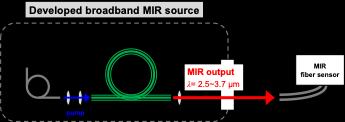
Credit: National Institute for Fusion Science
A research team of the National Institutes of Natural Sciences, National Institute for Fusion Science and Akita Prefectural University have successfully demonstrated a broadband mid-infrared (MIR) source with a simple configuration. This light source generates highly-stable broadband MIR beam at 2.5-3.7 μm wavelength range maintaining the brightness owing to its high-beam quality. Such a broadband MIR source facilitates a simplified environmental monitoring system by constructing a MIR fiber-optic sensor, which has the potential for industrial and medical applications.
In the MIR wavelength region, there are many strong absorption lines of molecules due to the change of their rotational and vibrational states. Therefore, by using MIR sources, we have promising opportunities to develop sensitive remote monitoring systems of practical use. In particular, a fiber-optic sensor based on MIR absorption spectroscopy has great potential as the next-generation gas detecting device, e.g., for an exhaust gas monitor at an industrial plant, breath analysis for medical purposes, and other uses. However, there is the remaining issue of the absence of a suitable MIR source exhibiting broadband spectrum and high-beam quality. In this work, the research team has demonstrated an ultra-broadband amplified spontaneous emission (ASE) source at the MIR region, which meets the requirements for developing the fiber-optic sensor.
In order to obtain the MIR emission, the research team has developed optical fiber made of fluoride glass co-doped with trivalent ions of Er (the atomic number 68) and Dy (66). This fiber enables a simple and low-cost configuration of ASE light source with diode-pumping (Fig. 1) by means of energy transfer from Er^3+ to Dy^3+. A broadband and moderate-power ASE light source of 2.5-3.7 μm wavelength (Fig. 2) was experimentally investigated for the optimum design of fluoride fiber in terms of ion concentration, fiber length, pumping configuration, and pumping power. In addition, this light source exhibits excellent beam quality resulting in high-coupling efficiency with an external optical fiber.
Assistant Professor Hiyori Uehara in the research team states that, “Our new light source can facilitate a simplified MIR fiber-optic sensor device for various practical applications. For example, an environmental monitoring system in the industrial plant, stand-off detection of hazardous objects, disease diagnosis by breath analysis, inspection of fiber-optic devices, and others. Ongoing detailed research demonstrating highly-sensitive multiple-gas detection using a MIR fiber sensor will be performed and reported in the near future.”
###
Science Contact:
Dr. Hiyori Uehara, NIFS Assistant Professor
[email protected]
Media Contact
Kentaro Yaji
[email protected]
Related Journal Article
http://dx.




